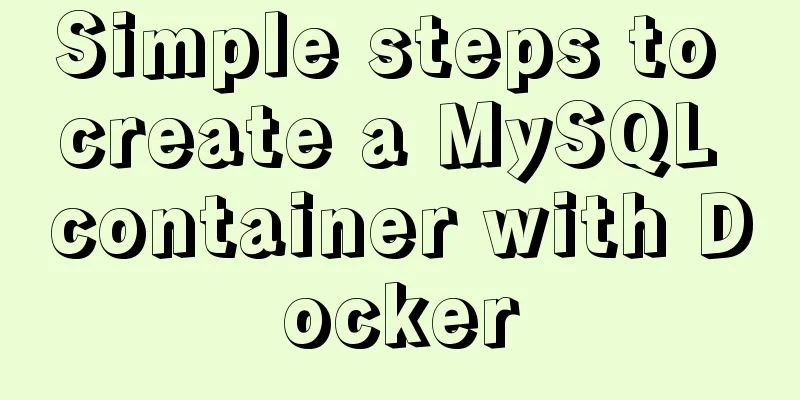Super detailed basic JavaScript syntax rules

01 JavaScript (abbreviated as: js)js is divided into three parts:
What is JavaScript?
Note: 1. Compiled language is a language that needs to be translated into a binary language that the computer can recognize before it can be executed. 2. The front-end foundation is HTML (markup language, display data) CSS (beautify the page) JavaScript (user and browser interaction) The original name of js is not JavaScript, but LiveScript What is the role of js? Solve the problem of interaction between users and browsers js code can be written in three places:1. In the HTML file, write the js code in the script tag 2.js code can be written in the html tag
<script>
//js code alert("Study hard and make progress every day"); //Pop up a dialog box on the page</script>
<input type="button" value="button" onclick="alert('Clicked');"/>3. You can write js code in the js file, but you need to introduce src="js path" in the script tag in the html page 02 OperatorsOperators: some symbols used for calculation
var num=10; num+=10;----->That is: num=num+10; console.log(num);20
Relational operators:> < >= <= ==Not strict === Strict != loose inequality !== Strict inequality Relational operation expression:Expressions connected by relational operators The result of a relational expression is of Boolean type. Logical operators:&&—Logical AND – AND ||—Logical OR—Or !—Logical NOT—Negation—Negation Logical operation expression:Expressions connected by logical operators
If one is false, the whole result is false
If any one is true, the whole result is true
The result of expression 1 is true, and the whole result is false The result of expression 1 is false, and the whole result is true
var num1=10;
var num2=20;
console.log(num1==num2&&5>6 )
var num=20;
console.log(num>10||5<0 )
var flag = false;
console.log(!flag )
var num=10;
var sum=(num+10)*5;
console.log(sum
var result = (4 >= 6 || '人' != '狗' && !(12 * 2 == 144) && true) ;
console.log(result);
var num = 10;
var result2 =( 5 == num / 2 && (2 + 2 * num).toString() === '22') ;
console.log(result2);
var num=20;
var result = num/3; //num variable modulo 3 ---> remainder of 10/3 console.log(parseInt(result)
var num=20;
var result = num%3; //num variable modulo 3 ---> remainder of 10/3 console.log(result)
var num=10;
var sum=(num+10)+1
var num = 20;
num %= 5;
// num=num-5;
console.log(num )
var str="5";
var num=5;
console.log(str===num )
console.log(5>10);//false
console.log(5>=5);//true
console.log(5>3);//true
console.log(5==10);//false03 JS variablesNote on variable names - naming of variable names:1. Follow the camel case naming convention (the first letter of the first word is lowercase, and the first letters of all subsequent words are uppercase) 2. Variable names should be meaningful 3. Variable names should be standardized 4. Keywords cannot be used (some words that come with the system cannot be used) Declare variables and initialize them - Initialize variables - declare variables and assign values Declare a variable named num to store a number 100 var num=110; Output the value of this variable alert(num); // pop-up window The browser console is in the console option in the developer tools in the browser (shortcut key: F12) console.log(num); // Output the content in the browser console Declare multiple variables and assign values to them one by one var num1,num2,num3;//declaration//assign values num1=10 in sequence; num2=20; num3=30; Declare multiple variables and assign values var num1=10,num2=20,num3=30; var num=10; var $break=10; var shuZi=10; Note: All data operated is in memory.
04 JS variable functionThe function of variables is to store data or operate data Variable declaration (var has variable name, but no value) Variable initialization (var has variable name and value) Variable declaration method:
var number; // variable declaration, no value is assigned at this time, //Declare multiple variables at once var x, y, z, k, j; //All are declarations, no values are assigned //Variable initialization (variables are declared and assigned values at the same time) // = means: the meaning of assignment //store a number 10 var number = 10; //Store a 5 var number2 = 5; //Store a person's name var name = "Xiao Hei"; //Store true var flag = true; //Store a null--->equivalent to empty var nll = null; //Store an object var obj = new Object(); 05 Swapping JS variablesUse third-party variables for swappingvar num1=10; var num2=20; // Take the value of the variable num1 and put it in the temp variable var temp=num1; // Take the value of the variable num2 and put it in the variable num1 num1=num2; // Take the value of temp variable and put it in num2 variable num2=temp; console.log(num1);//20 console.log(num2);//10 The second method of exchange: generally applicable to the exchange of numbers
var num1 = 10;
var num2 = 20;
// Take the value in the variable num1 and the value in the variable num2, add them together, and reassign them to the variable num1 num1 = num1 + num2; //30
// Take the value of num1 and num2, and assign the result of subtraction to num2
num2 = num1 - num2; // 10
// Take the value of num1 and num2, and assign the result of subtraction to num1
num1 = num1 - num2; // 20
console.log(num1, num2);
Note: Variable names cannot be repeated, because the latter will overwrite the former. var num1=10; var num1=20; console.log(num1);
Extended variable exchange: just look at the code, no need to understand (bit operations) var num1 = 10; var num2 = 20; num1 = num1 ^ num2; num2 = num1 ^ num2; num1 = num1 ^ num2; console.log(num1, num2); 06 CommentsComment method:
//Single-line comment: usually used above a line of code /Multi-line comments: generally used above a function or a section of code/
//The commented code is not executed //console.log("Haha, I'm beautiful again");
//console.log("second line");
//Declare variables and initialize them //var num=10;07 JS data typesValue type (basic type):String Numbers - integers and decimals (Number) Boolean Null Undefined Symbol Reference data types:Object Array Function
var num;
console.log(num+10); //NaN-----not an number---->Not a number var num;
console.log(num);
How to get the data type of this variable? Use typeof to get //typeof syntax* to get the data type of this variable!
* typeof variable name * typeof (variable name)
*
var num = 10;
var str = "Xiaobai";
var flag = true;
var nll = null;
var undef;
var obj = new Object();
//Use typeof to get the type of the variable console.log(typeof num);//number
console.log(typeof str);//string
console.log(typeof flag);//boolean
console.log(String(nll));//is null
console.log(typeof nll);//Not null
console.log(typeof undef); //undefined
console.log(typeof obj);//object
console.log(typeof(num));08 JS digital type// Number type: integer and decimal var num = 12; num=20; // integer num=98.76; // decimal (in other languages, floating point type --- single precision, double precision floating point) // All numbers are of type number 09 baseWhat bases can be represented in js?var num=10;//decimal var num2=012;//octal var num3 = 0x123; // hexadecimal var num=12;//decimal console.log(num); var num2=012;//octal systemconsole.log(num2); var num3=0x1a; //hexadecimal console.log(num3); var num=0x1f; console.log(num); Notice: To represent decimal: just a normal number To represent octal: start with 0 To represent hexadecimal: start with 0x 10 NaNDon't use NaN to verify whether it is NaN
var num;
console.log(num+10==NaN);
console.log("Hello"=="I am fine");How to verify whether the result is NaN? You should use isNaN()var num; //-----The variable is declared but not assigned a value, the result is: undefined Isn't it a number----->Isn't it a number? NaN--->Not a number console.log(isNaN(10)); To determine if the result is not a number, use isNaN(variable name)var str="Hello"; var num; var sum=num+10;//NaN console.log(sum); console.log(isNaN(sum)); // true if it is not a number, false if it is a number Note: Do not use NaN to determine whether it is NaN, you should use isNaN(value or variable) 11 Type Conversion1.parseInt();//Convert to integer
console.log(parseInt("10"));//10
console.log(parseInt("10afrswfdsf"));//10
console.log(parseInt("g10")); //NaN
console.log(parseInt("1fds0"));//1
console.log(parseInt("10.98"));//10
console.log(parseInt("10.98fdsfd"));//102.parseFloat()//Convert to decimal
console.log(parseInt("10"));//10
console.log(parseInt("10afrswfdsf"));//10
console.log(parseInt("g10")); //NaN
console.log(parseInt("1fds0"));//1
console.log(parseInt("10.98"));//10
console.log(parseInt("10.98fdsfd"));//103.Number(); //Convert to numbers
console.log(Number("10"));//10
console.log(Number("10afrswfdsf")); //NaN
console.log(Number("g10")); //NaN
console.log(Number("1fds0")); //NaN
console.log(Number("10.98"));//10.98
console.log(Number("10.98fdsfd"));//NaNNote: If you want to convert an integer, use parseInt(); if you want to convert a decimal, use parseFloat() Want to convert numbers: Number(); is stricter than the above two methods Other types to string types1. toString()// var num = 10; // console.log(num.toString());//String type// //2 String(); // var num1 = 20; // console.log(String(num1)); If the variable makes sense, call .toString() to convert it. If the variable does not make sense, use String() to convert it.
var num2;
console.log(num2.toString());
var num3=null;
console.log(num3.toString());
//This can be var num2;
console.log(String(num2));
var num3=null;
console.log(String(num3));
Other types to Boolean types
console.log(Boolean(1)); //true
console.log(Boolean(0));//false
console.log(Boolean(11));//true
console.log(Boolean(-10));//true
console.log(Boolean("哈哈"));//true
console.log(Boolean(""));//false
console.log(Boolean(null));//false
console.log(Boolean(undefined)); //false12 JS basic code standards
The above is the details of the super detailed basic JavaScript grammar rules. For more information about JavaScript grammar rules, please pay attention to other related articles on 123WORDPRESS.COM! You may also be interested in:
|
<<: MySQL MyISAM default storage engine implementation principle
>>: Example code for configuring monitoring items and aggregated graphics in Zabbix
Recommend
A brief discussion on JS regular RegExp object
Table of contents 1. RegExp object 2. Grammar 2.1...
Implementation of VUE infinite level tree data structure display
Table of contents Component recursive call Using ...
VMware ESXi installation and use record (with download)
Table of contents 1. Install ESXi 2. Set up ESXi ...
Some basic instructions of docker
Table of contents Some basic instructions 1. Chec...
Several ways to use v-bind binding with Class and Style in Vue
Adding/removing classes to elements is a very com...
Let the web page redirect to other pages after opening for a few seconds
Just add the following code to achieve it. Method ...
Solution to the problem that MySQL in Windows system cannot input and display Chinese
Step 1: Use Notepad to open the "my.ini"...
How to reduce the root directory of XFS partition format in Linux
Table of contents Preface System environment Curr...
How to Easily Remove Source Installed Packages in Linux
Step 1: Install Stow In this example, we are usin...
Let's talk in detail about how the NodeJS process exits
Table of contents Preface Active withdrawal Excep...
Detailed explanation of the implementation of manual and automatic tracking of WeChat applet (Taro)
If every company wants to increase its user base,...
HTML+CSS to achieve drop-down menu
1. Drop-down list example The code is as follows:...
Element avatar upload practice
This article uses the element official website an...
Implementation of CSS equal division of parent container (perfect thirds)
The width of the parent container is fixed. In or...
jQuery implements the mouse drag image function
This example uses jQuery to implement a mouse dra...










